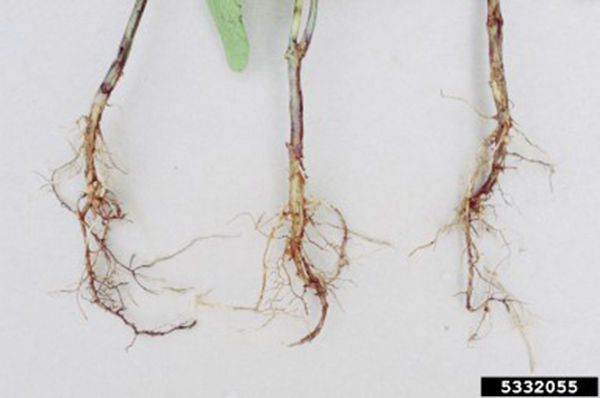Don’t Let Rhizoctonia Sneak Up on Soybean Seedlings
November 22, 2016

Rhizoctonia solani ranks high among the fungal diseases that infect soybean seeds, roots and seedlings each year. The common soilborne disease survives in the soil as sclerotia, which are strong fungal survival structures. Rhizoctonia is commonly found in most soils across U.S. soybean growing regions.
Typically, Rhizoctonia in soybeans thrives as a seedling disease, but damage may occur in more mature plants. The higher the infection level in the soil, the greater the potential to cause significant damage. Rhizoctonia represents one of the common soilborne diseases affecting early-season soybeans, along with Pythium spp., Phytophthora sojae and Fusarium spp.
Identification
Rhizoctonia disease can cause both pre-emergence and postemergence death of soybean plants. Seed decay from Rhizoctonia infection occurs pre-emergence and often is not visually detected in a field until damage has already occurred. Postemergence symptoms on soybean seedlings appear as brown or reddish-brown lesions on stems and roots just below the soil line. If lesions become sunken and stems become girdled, the plants can die.
Rhizoctonia-infected soybean plants can become stunted, resulting in uneven stands in patches throughout a field. As plants mature, the disease can cause a reddish-brown, dry root rot to form in the stem base. These dry stems may snap off when high winds disturb a field. Foliar symptoms of Rhizoctonia appear as yellowing, wilting leaves.
Crop Damage
With high levels of Rhizoctonia infection in soils, pre- and postemergence damping-off can reduce stands by 50 percent or more, according to North Dakota State University.
The most severe Rhizoctonia damage generally occurs in fields that are poorly drained, especially after the onset of wet, warm weather. Use recommended best management practices for planting soybeans in optimum conditions.
Early Rhizoctonia disease infection can result in stands so weak that replanting may be needed. Later in the growing season, soybean plants infected with Rhizoctonia may not survive stresses such as hail, wind, drought, insect feeding or soybean cyst nematode (SCN) feeding. Rhizoctonia fungi can enter plant wound injury sites caused by these sources and make plants susceptible to infection.
Thus, keep in mind that controlling SCN not only helps manage Rhizoctonia but also another closely related fungal disease with similar symptoms: Fusarium virguliforme, which causes sudden death syndrome (SDS).
Rhizoctonia disease can also significantly decrease nodulation, which is an important and beneficial symbiotic relationship between Rhizobia bacteria and the soybean plant. Nodulation allows nitrogen gas to be fixed in a plant-available form in the root.
Managing Rhizoctonia Disease in Soybean Seedlings
To protect soybean yields from Rhizoctonia, farmers have several management options ranging from variety selection, seed treatments, scouting and cultural practices. High-quality seed and good agronomic practices go a long way to ensure soybean seedling health and vigor.
Variety Selection
Choose soybean varieties with some tolerance to Rhizoctonia, but keep in mind that no variety provides complete resistance to this disease. It’s best to select two or three high-yielding varieties that provide the least susceptibility to common diseases found on your individual farm.
Seed Treatments
Seed treatments protect planted seed and young seedlings from seedborne and soilborne diseases and other threats to plant health and yield for several weeks after planting. Using the correct fungicide seed treatment and rate is one way to provide effective and economical seedling disease control in soybean production. Good control of Rhizoctonia solani and other pests that cause the most damaging seedling diseases, including Fusarium spp. and Pythium spp., can be achieved with some commercially available seed treatment fungicides such as EverGol® Energy SB or Trilex® 2000. Be sure to check fungicide labels and ratings to make sure the product you choose is effective against the diseases you want to target.
Scouting
If you suspect Rhizoctonia while scouting, take samples and work with your county Extension agent to confirm a diagnosis. Crop identification guides are also helpful. If infestations are severe enough a replant might be warranted since there are no means of corrective chemical control of Rhizoctonia root and stem rot. For fields with a history of Rhizoctonia, an appropriate fungicidal seed treatment would be recommended.
Cultural Practices
Crop rotation can help deter diseases such as Rhizoctonia, but common rotational crops of soybeans such as corn, cotton and wheat are also susceptible to Rhizoctonia. In areas where continuous soybeans are grown, cultivation can break down crop residue that harbors Rhizoctonia and other diseases. Always plant disease-free, certified seed. Season-long weed control also helps protect against disease and other pests.
View our product portfolio to learn more about soybean disease control options from Bayer or contact your local Bayer representative.